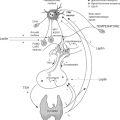Introduction to Thyrotoxicosis
Lewis E. Braverman
David S. Cooper
This chapter introduces the section on thyrotoxicosis, a common and important thyroid disorder. It has multiple causes, and its recognition and treatment are important components of endocrine practice.
We use the term thyrotoxicosis to mean the clinical syndrome of hypermetabolism and hyperactivity that results when the serum concentrations of free thyroxine (T4), free triiodothyronine (T3), or both, are elevated. The term hyperthyroidism refers to sustained increases in thyroid hormone biosynthesis and secretion by the thyroid gland. Thus, the terms thyrotoxicosis and hyperthyroidism are not synonymous. While many patients with thyrotoxicosis have hyperthyroidism, others – e.g., those in whom thyrotoxicosis is caused by release of excess hormone from the thyroid in the absence of increased synthesis such as thyroiditis or exogenous thyroid hormone administration – do not.
The clinical manifestations of thyrotoxicosis are, for the most part, independent of its cause. However, certain features of the illness often provide clues about the cause of thyrotoxicosis in an individual patient. These features include the duration of thyrotoxicosis, the size, shape, and texture of the thyroid gland, and the presence or absence of tenderness or the extrathyroidal manifestations of Graves’ disease. For example, at the time of diagnosis, patients with thyrotoxicosis caused by thyroiditis rarely have had symptoms for more than a few weeks, whereas those with Graves’ disease or toxic nodular goiter have usually been symptomatic for at least several months. An attempt should be made to determine the cause of thyrotoxicosis in all patients because knowledge of the cause determines prognosis and guides therapy.
The causes of thyrotoxicosis can be subdivided into those disorders that are associated with hyperthyroidism and those that are not (Table 17.1). All these disorders are discussed in detail in the following chapters. Among the causes of spontaneously occurring thyrotoxicosis, Graves’ disease is the most common; its frequency as the cause of thyrotoxicosis ranges from approximately 60% to 90% in different regions of the world. Most of the remaining cases are caused by toxic nodular goiter, autonomously functioning solitary thyroid adenomas (toxic adenomas), or the several types of thyroiditis. Except for thyrotoxicosis due to the ingestion of excess thyroid hormone, all the other causes of thyrotoxicosis are rare.
While many patients with thyrotoxicosis have overt clinical and biochemical disease, thyrotoxicosis may be subclinical. Subclinical thyrotoxicosis is defined as normal serum free T4 and T3 concentrations and low serum thyrotropin (TSH) concentrations; the patients usually have no symptoms of thyrotoxicosis, but if present they are usually mild and nonspecific. The causes of overt and subclinical thyrotoxicosis are similar, but the most common causes of subclinical thyrotoxicosis are exogenous thyroid hormone administration and the early phase of Graves’ disease and toxic nodular goiter. However, not infrequently the diagnosis remains unknown and the subclinical state can remain stable for a prolonged period of time. Whether and how patients with endogenous subclinical thyrotoxicosis should be treated is controversial (see Chapter 33).
Stay updated, free articles. Join our Telegram channel

Full access? Get Clinical Tree








